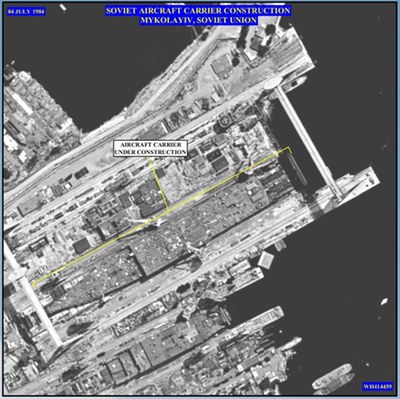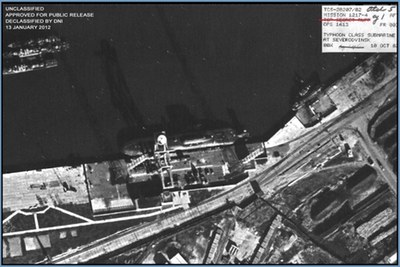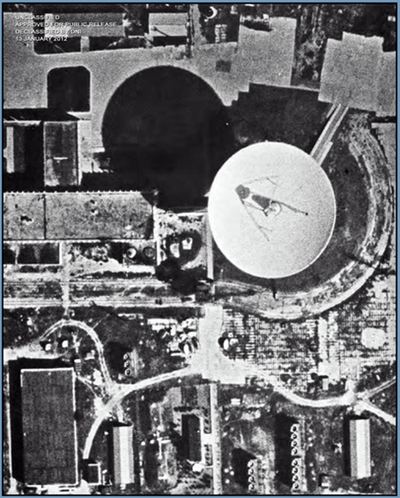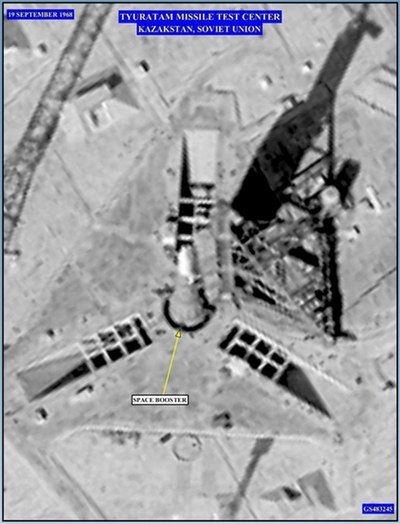The geometry of shadowsby Dwayne A. Day
|
| This was not the first time that an American satellite had spotted the N-1, but it was the best look that American intelligence analysts had ever gotten, enabling them to make measurements and evaluate the rocket’s stages and dimensions. |
On this September day the Americans got lucky. The skies over the primary Soviet rocket and missile test facility were clear. And down at Tyura-Tam, as it was then known, the Soviets were doing something very interesting. They had rolled out their Moon rocket, a giant vehicle as tall as a Saturn V. It occupied one of their two triad-shaped launch pads. The Americans photographed it at incredibly high resolution. The CIA labeled this the “J vehicle” because they had designated its launch facility at Tyura-Tam as “Complex J” (the Sputnik launch pad, the first identified by the CIA in U-2 overflights, had been designated Complex A). Much later western analysts came to know it as the N-1.
This was not the first time that an American satellite had spotted the large vehicle, but it was the best look that American intelligence analysts had ever gotten, enabling them to make measurements and evaluate the rocket’s stages and dimensions. Although the intelligence report on this observation remains classified, others have been declassified. For instance, on October 3, a report to the Committee on Imagery Requirements and Exploitation, the organization that selected targets for American reconnaissance satellites to photograph, reported on the output of mission 4316 and stated that “The launch vehicle was still on the pad at Complex J-1 on 24 September.” In February 1969 another report indicated that the intelligence analysts had calculated the vehicle’s height as 335 feet (102 meters) tall.
In February, this rocket lifted off the pad at what is now known as Baikonur, traveled downrange… and blew up. Western intelligence agencies may have gotten word of a launch, but they never tracked anything in flight or in orbit, and later reconnaissance photos of the area around the launch facility revealed no debris as evidence of a failed launch, and so subsequent declassified reports on the Soviet space program contain no information on this first failed Soviet Moon rocket test.
In early July 1969, shortly before Apollo 11 lifted off for the Moon, the Soviets launched their second J-vehicle. It rose up off the launch pad a few hundred meters, and then blew itself to smithereens, raining debris and fuel down onto the pad. This time seismic sensors ringing the Soviet landmass registered a massive explosion, and seismologists were able to triangulate the noise to the launch facility. When an American satellite next overflew Tyura-Tam, analysts on the ground were expecting something.
 Aircraft carrier Kuznetsov under construction at the Nikolaev shipyard photographed by a KH-8 GAMBIT reconnaissance satellite on July 4, 1984. [larger version of image] (credit: NRO) |
The carrier
Nearly sixteen years later, on July 4, 1984, GAMBIT mission 4354 flew over the Nikolaev shipyard during its reconnaissance operations. GAMBIT used film, which it returned to Earth in two film return capsules. The capsule was caught in midair by an aircraft flying out of Oahu. The plane returned to Hawaii and the capsule was transferred to another plane and flown to California, then flown to Rochester, New York, where Eastman Kodak performed its magic, developing the film and duplicating it before sending it on to Washington. This entire process of film recovery to delivery often took several days, meaning that the most recent photography from a GAMBIT mission was several days old before an intelligence analyst could look at it. Because of this delay, the National Reconnaissance Office, which developed and operated the intelligence satellites, had build a new spacecraft first launched in 1976. Known as KENNEN, or the KH-11 to its users, this new spacecraft sent its imagery over an encrypted data link, meaning that its photographs could be viewed within minutes of being taken.
Although the first KENNEN flew in 1976, the GAMBIT still had value. Its film was very high resolution, better than anything that the KH-11 could produce. And so the GAMBIT stayed in service for another eight years. Mission 4354 was the last GAMBIT mission. This was its farewell tour.
| This imagery release was somewhat of a surprise, because even though the satellite programs were declassified in September, the National Geospatial Intelligence Agency, which owns the photographs they took, did not seem to be in any rush to release any imagery in time for the program declassification. |
As the spacecraft overflew Nikolaev, its powerful camera photographed something that American intelligence analysts had been following for several years, the construction of the largest Soviet naval vessel they had ever seen. The vessel was so big, in fact, that its hull was being constructed in two parts, bow and stern side-by-side, because the Soviet Union lacked the kind of massive drydocks that the United States used for constructing its supercarriers. The ship had first been laid down in February 1983 and was still a year and a half from launching. GAMBIT photographs that came back from space showed in very high resolution as the decks were added and the hull built up, undoubtedly providing significant information on the ship’s internal layout, and vulnerabilities. The reconnaissance photos undoubtedly revealed the sixteen large silos for surface-to-surface missiles underneath the carrier’s flight deck.
 Typhoon class ballistic missile submarine photographed at Severodvinsk in the former Soviet Union, photographed by a KH-9 HEXAGON satellite on October 10, 1982. [larger version of image] (credit: NRO) |
Later in 1984, a KENNEN satellite would photograph the same shipyard, revealing further construction. Several photographs ended up on the desk of an analyst at the Naval Intelligence Support Center (NISC) in Suitland, Maryland, outside of Washington. An analyst who worked at NISC named Samuel Loring Morison took the photos, cut off their security markings, and mailed them to London-based Jane’s, which regularly published Jane’s Fighting Ships, and employed Morison as editor of their American ships section. Jane’s also published Jane’s Defense Weekly, and the company promptly put one of the photographs on the cover of their August 11 issue.
It did not take long for the Naval Investigative Service and the FBI to identify Morison as the source of the leak and he was promptly arrested and charged with espionage and theft of government property. At the time it was unprecedented to charge a person with espionage for leaking classified information to the media. Today, the Obama administration does it all the time for lower-level employees, although people who work in the White House or at the Cabinet level regularly reveal classified information to reporters such as Bob Woodward and are not prosecuted. Morison was sentenced to two years in prison. Apparently because of the inconsistency in applying the espionage statute to those who leaked to the press, he was pardoned by President Clinton in 2001.
Although the carrier was launched in December 1985, it was not commissioned until 1991 and did not become fully operational until 1995, its long gestation a result of the collapse of the Soviet Union and Russia’s subsequent economic difficulties. Initially named Riga, renamed Leonid Brezhnev, then Tbilisi, it entered service as Admiral of the Fleet of the Soviet Union Kuznetsov. She (or “he”, as the Russians refer to ships in masculine terms) is still in service today, apparently about to undergo a major overhaul. Apparently because of funding problems, the ship has not deployed much during her service and at times has apparently spent years at dock. (Sailors derisively refer to ships that rarely sail as “buildings”.) The second ship in the class, Varyag, was not completed and eventually sold to China. After many years rusting away at pier side, the Chinese overhauled and finished the ship and it now serves as a training aircraft carrier, apparently to help the Chinese develop a more capable indigenously-built carrier force of their own. China may get more use out of its carrier than the Russians have.
 A KH-9 HEXAGON satellite photographed this deep space tracking antenna a Simferopol in the former Soviet Union in September 1982. [larger version of image] (credit: NRO) |
The National Reconnaissance Office recently released several images taken by the GAMBIT and the HEXAGON satellites. HEXAGON was a search satellite that entered service in 1971, with the last launch in 1986. Other released images include a Kiev class aircraft carrying cruiser, a space tracking site, and a massive Typhoon ballistic missile submarine of the type that inspired the bestselling book The Hunt For Red October. This imagery release was somewhat of a surprise, because even though the satellite programs were declassified in September, no images taken by these satellites were released at that time (only previously declassified imagery was displayed). These images were declassified by the Director of National Intelligence, after the National Geospatial Intelligence Agency reviewed them and others for release. The images have undoubtedly been degraded, because GAMBIT and HEXAGON’s best imagery capabilities remain classified. These photographs are hopefully the first in many yet to come, and will help us better understand the battles in the shadows of the Cold War.
